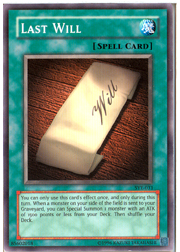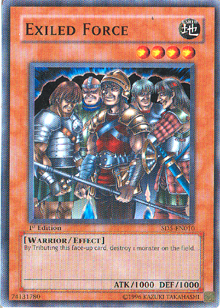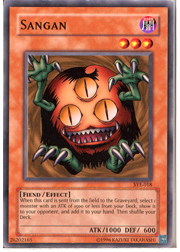
While raw draw power can be powerful, card selection is far more important. When drawing cards from the top of your deck, you might not draw the cards you want for your current matchup. Card selection gives you specific cards of your choosing instead of just more options from the top of your deck. Sangan is an example of card selection, allowing you to search your deck for many useful 1500 ATK or lower monsters that can help you maintain field presence.
 Last Will has recently become one of the more popular search cards in the game, ever since its rulings information was revised. It’s no surprise either. Last Will is effectively a faster Sangan, rarely forcing you to wait for that monster you want to get onto the field. There is no doubt that Last Will is a powerful card, but what makes this old goodie so incredible is its versatility.
Last Will has recently become one of the more popular search cards in the game, ever since its rulings information was revised. It’s no surprise either. Last Will is effectively a faster Sangan, rarely forcing you to wait for that monster you want to get onto the field. There is no doubt that Last Will is a powerful card, but what makes this old goodie so incredible is its versatility.
Last Will is a tough spell to understand at first. You can only activate it during your main phases, like any normal spell card. It leaves a lingering effect on the field that allows you to search your deck for a monster with an ATK of 1500 or less at any point during the turn, once a monster on your side of the field is sent to the graveyard.
This may be a little confusing, so here are some examples:
Mike is currently playing against Jason. Jason’s deck, a Rescue Cat rush deck, has some strong defensive plays in monsters like Nimble Momonga. Knowing that Jason’s face-down monster is most likely the annoying squirrel, Mike decides to play Last Will. After that, he summons Exiled Force, and chooses to tribute his Warrior for its effect, destroying Jason’s face-down monster. Mike then chooses to resolve the effect created by the Last Will he played, and special summons Don Zaloog from his deck to attack with this turn. “Ack! Not cool!” shouts Jason as Don Zaloog attacks and rips the linchpin Rescue Cat out of his hand, giving Mike a good chance to win.
 As you see, once you activate Last Will, you can trigger its effect at any point during the turn after a monster of yours is sent from your field to your graveyard. In this case, tributing Exiled Force fulfills the conditions of Last Will. At any point during the rest of the turn, you can special summon a monster via Last Will’s effect. In the example, I did so during the main phase. However, you aren’t restricted to the main phase, as shown in this next example.
As you see, once you activate Last Will, you can trigger its effect at any point during the turn after a monster of yours is sent from your field to your graveyard. In this case, tributing Exiled Force fulfills the conditions of Last Will. At any point during the rest of the turn, you can special summon a monster via Last Will’s effect. In the example, I did so during the main phase. However, you aren’t restricted to the main phase, as shown in this next example.
Mike plays Last Will and activates Premature Burial to special summon D. D. Assailant from his graveyard, immediately attacking with it. Unfortunately, Jason has a face-down trap card, which he activates: Sakuretsu Armor. D. D. Assailant is destroyed. Mike then chooses to resolve the effect created by the Last Will he played during the battle phase. This allows him to special summon Don Zaloog from his deck. Mike then attacks with Don Zaloog, since it was special summoned during the battle phase.
That’s a pretty nifty trick, isn’t it? With this strategy, you can use Last Will as a safeguard guarantee to deal some damage (either to your opponent’s field or life points) during that turn. It is important to note that you cannot activate Last Will’s effect during the damage step, but you can special summon a monster with the lingering effect of your spell card during any other part of the turn. This also includes the end phase.
You also aren’t required to play Last Will before a monster is sent from your field to your graveyard. You can play it, and then immediately special summon a monster when your spell resolves if you already had a monster sent from your field to your graveyard. This could be a good strategy when summoning a monster like Mobius the Frost Monarch, giving you a chance to see if your opponent has any way to mess up your plans with an untimely Scapegoat.
 There are two decks right now in this format that can truly harness the incredible versatility and search power of Last Will. In the Monarch-based decks, Sangan acts as your second Treeborn Frog: excellent tribute material for a Monarch summon. After all, the little amphibian makes monsters like Thestalos the Firestorm Monarch quite a good deal. Last Will acts as a third copy of Treeborn Frog in these decks, reducing the damage done to your field by traps like Sakuretsu Armor (which is steadily increasing in popularity with the fading presence of Royal Decree). You can also trigger your own Last Will easily with Exiled Force, tributing a monster to summon a Monarch, or any other tribute summon for that matter. Once you have Treeborn Frog online in this deck, your opponent is usually going to have a very hard time winning.
There are two decks right now in this format that can truly harness the incredible versatility and search power of Last Will. In the Monarch-based decks, Sangan acts as your second Treeborn Frog: excellent tribute material for a Monarch summon. After all, the little amphibian makes monsters like Thestalos the Firestorm Monarch quite a good deal. Last Will acts as a third copy of Treeborn Frog in these decks, reducing the damage done to your field by traps like Sakuretsu Armor (which is steadily increasing in popularity with the fading presence of Royal Decree). You can also trigger your own Last Will easily with Exiled Force, tributing a monster to summon a Monarch, or any other tribute summon for that matter. Once you have Treeborn Frog online in this deck, your opponent is usually going to have a very hard time winning.
The other major deck that uses Last Will effectively is the Warrior toolbox aggro/control deck. Most veteran players should be familiar with this deck, since it’s usually the all-around solid choice for an unknown environment. Warriors are already consistent with their raw card selection power, fueled by multiple copies of Reinforcement of the Army. Last Will can function as another copy of that trademark Warrior search card. As mentioned, it’s also a great combo with Exiled Force, and a powerful tool for maintaining your field presence during the battle phase, allowing you to keep pressure on your opponent’s life points. After all, if your opponent were to destroy any of your monsters with a monster effect or a trap card, you could simply use Last Will during the battle phase to get a shot in directly with Don Zaloog or any number of other excellent 1500 ATK or lower monsters!
Out of all the other spell cards, Last Will is probably the one with the fastest transition from dust-collecting common to tournament-winning staple. It was a sleeper power card for ages, and now players finally recognize it for its full potential. Remember that Last Will can be a tricky card to use effectively, but if you plan out the timing of it properly and make sure to capitalize on all of its strengths, then it will win you more than your share of duels during a tournament.
If you have any questions or comments regarding this or previous articles of mine, feel free to e-mail me at Mrosenberg@metagame.com.